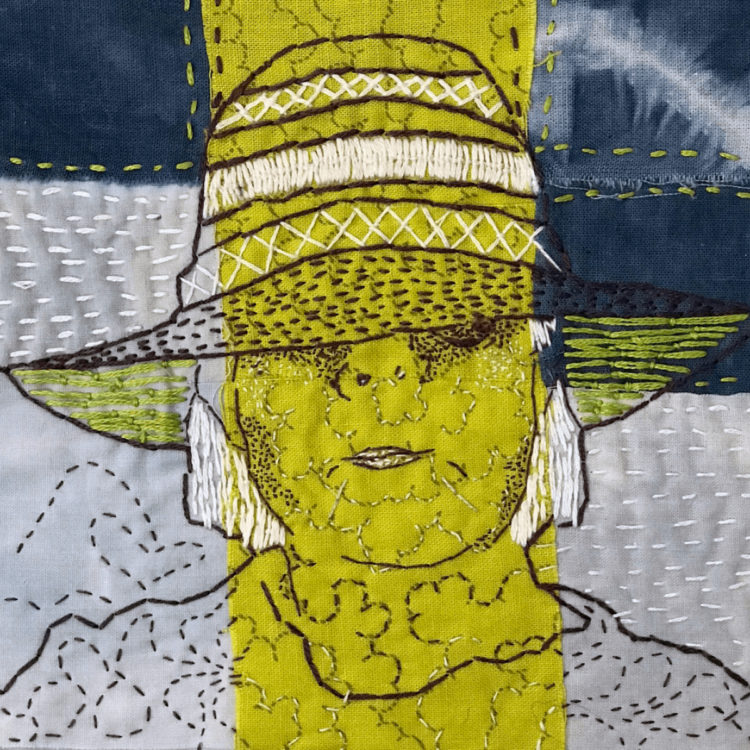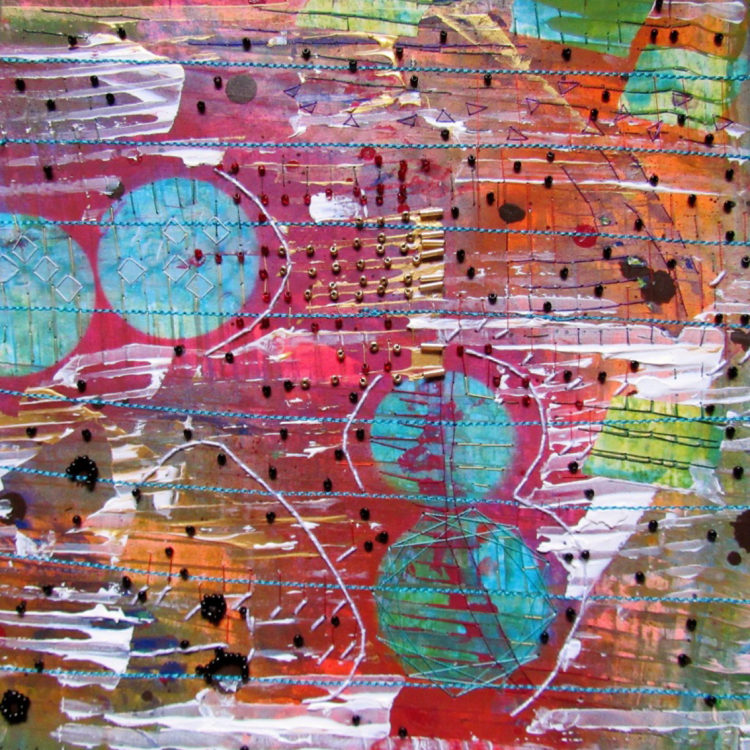6 creative strategies for getting started with stitch

It’s time.
Time to explore your creativity.
Time to expand your toolkit of textile techniques.
Time to embrace a fulfilling stitch practice.
You know it’s time because you find yourself gazing awestruck at someone else’s experiments with fabric, thread and mixed media.
You know it’s time, because you still feel the warmth of your own grandmother’s pleasure over a wonky-stitched felt peg bag you made her when you were nine, or because you find yourself getting just a little too excited over a scrap of dove grey linen.
So, what’s stopping you from threading that needle and starting your own creative adventure?
Identify your creative barriers
Maybe the reason your creative process has been a bit random and inconsistent throughout the years is because of Life Happens Syndrome, making time a scarce resource? Earning money to pay the bills, chasing round after children or grandchildren and the whole caboodle of life squeezes every last hour from your diary, and there’s nothing left for yourself.
Sometimes there are just too many ideas whizzing about in your head, and choosing one to work on brings on a bout of creative paralysis.
“So this is my dilemma. So many ideas! Will I do a rough edge or turned-under appliqué? Will I paint the background fabric first? Will I print photos on fabric to incorporate in the piece? Will I finish the piece with hand stitching or machine stitching?”
Perhaps your inner critic shouts more loudly than your inner coach, telling you that you’re not creative, or that if you can’t do it perfectly then you shouldn’t do it at all.
Perhaps you can’t always count on your energy. Sometimes your health can let you down, leaving you depleted and disappointed that you can’t always turn up for yourself.
“Apart from standard aches and pains I am getting debilitating pain with my sewing hand. This has become particularly bad these last six months and it’s the main reason why it’s so hard to keep up regular practice.”
Sometimes you’ve the will to create but, without inspiration, it feels like you’ve started the car but there’s nowhere to go.
Maybe there’s absolutely nothing stopping you. That can be its own barrier! You have time, resources, energy and the will to create. But with no boundaries or deadlines, absolute freedom can be overwhelming. Where do you start? Where do you finish?
Taking that first step isn’t easy, and there are a truckload of reasons, feelings and fears that make that first step near impossible. But, beneath all this, your creative spirit is alive and well, and doing its best to break out. So, give it a helping hand with an attitude of kindness towards yourself, and curiosity towards discovering more about your own creativity.
Here’s how…



1 Make it manageable
Start small. Start tiny. Find pockets of time and use that time to practice a stitch or play with colours and textures that resonate with you. No-one’s expecting a masterpiece.
“When a child learns how to play the piano, we don’t expect them to compose an original symphony. They play “Mary Had A Little Lamb” over and over and over again, and then progress to harder, more challenging compositions as they go.”
Textile artist Clarissa Callesen
And it’s not a race. Slow progress is better than no progress. Work in short bursts.
Break a workshop exercise into teeny chunks and work on a chunk at a time.
“Doing workshops online that I can revisit in my own time, helps me break things into manageable chunks. So if I don’t have four hours to work on a piece, I can get something done in 30 minutes, and then tomorrow, I can spend 30 more minutes. And eventually, I’m going to have something to show for it.
Before I thought I had to have big chunks of time that I put into art and production. Now I understand that’s not the case and I am working far more regularly because of it.”
Laura Otten, Stitch Club member
Start by making samples rather than aiming for a whole piece of textile art. Sampling is a focused and effective way of developing your unique creative voice without investing time and love into one huge piece, only to be discouraged if you don’t like the result (ahem, see Focus on the process below).
“Samples give me the confidence to tackle larger or more intricate pieces because I can try out a concept or thought beforehand and see how and where I could develop it.”
Textile artist Monica Bennett
2 Focus on the process
When you turn up to your creative projects without expectation of a good result, you free yourself to play rather than be perfect.
When you focus your attention on the process of making art, rather than on the piece of art itself, a strange thing happens. Your curiosity comes to the fore, and the spirit of experimentation envelops you. You’ll ask yourself questions, big and small, such as:
“What would happen if I used linen instead of wool?”
“How would a smaller backstitch change this eye shape?”
“How can I express my anger about the care system with stuff from my stash?”
“How can I honour my heritage using this old photo of great aunt Flo?”
Asking those questions gives you a way into your process. And within the possible answers to those questions lies creativity.



3 Play with limitations
It can be hard to begin if you’ve got too much choice: perhaps your head is spinning with ideas, or your cupboards are overflowing with beautiful fabric and every colour of thread.
And it can be just as difficult if you’ve no ideas at all, or all your stash cupboard contains is some well-fed, happy moths.
This is where playing with limitations comes into its own. When you limit yourself, when you create boundaries for yourself, you’re reducing the need for decisions and giving yourself more room to be creative. Paradoxically, limitations give you freedom.
In an online workshop, textile artist Sue Stone inspired members of Stitch Club to use just three fabrics, three threads and three colours to create strip woven textile art. Setting these parameters upfront empowered members’ creative processes, helped them avoid decision fatigue and overwhelm, and led to some stunning results.
4 Have fun with failure
“Detours are always more interesting than the main road.”
Conceptual artist Mary Kelly
Giving yourself permission to fail is one of the most empowering things you can do for your creativity. Perfectionism has no place in your practice. Mistakes are an adventure and an opportunity for creative growth.
When something goes horribly, hysterically “wrong”, your inner critic might pop out and tell you, “the dog could make a better job of that.’ Simply thank her for her opinion and move on. Keep stitching. Her voice will quieten down as you fail bigger, fail better and enjoy a voyage of discovery through your mistakes.
“I wasn’t happy with the look that my pale threads were giving my piece. So I started cutting the stitches to remove them, and things started fraying. But, actually, this looked really appealing, so I embraced my mistake, and kept the cut threads.”
Wendy Kirwood, Stitch Club member
You’ll learn just as much (if not more) from your failures as your successes. “Failure” is just feedback. It’s a positive part of your learning process and gives you a chance to reflect on what works, what doesn’t work and what you’d do differently next time.
And if disappointment does creep in when something turns out mad, bad or downright ugly, remember that disappointment is part of the artistic journey. Dance it out, stitch it out and keep creating. Embrace imperfection. Your imperfections are what makes you unique.
“Perfection is subjective. I prefer discovery. What you may think of as your imperfections as a stitcher help you to interpret what you see in a way that nobody else could.”
Gregory T Wilkins, Stitch Club tutor.



5 Add a little structure
When it’s hard to get started, a structured plan can help.
When you know what to do next, you spend less time thinking and more time stitching.
Structure gives you a clear starting point, a clear next point and so on, and, in between sessions, you may find that your subconscious incubates creative ideas that spring on you ready for the next session.
Create a self-directed plan or work through an online workshop, where the structure is already laid out for you. Whichever you choose, following a structure is a powerful way to practice techniques and explore your creativity.
6 Don’t seek to be original straight away
An effective way back into stitching is to choose a work or an artist you admire, and follow along with what they do. What is it about their work that you love?
“Being influenced by other people’s work is quite normal and it’s all part of the process of discovering more about yourself. You will eventually pull away from that and start introducing things into your work that are unique to you.”
Textile artist Sabine Kaner
When you’re inspired a piece of textile art, it’s not copying – it’s learning. After all, when you start learning piano, you don’t start with composing your own suite of preludes.
“Originality is a concept that we’ve put up on a pedestal as the ultimate. But I think that when we concentrate too much on originality it stops us following our own curiosity. Copying is normal. When you combine inspirations and techniques from different artists, you create the thing that is yours.”
Textile artist Clarissa Callesen
















Dear TA!
I’m hoping I’m not a year late to the party and that your advertised ‘something special’ is being revealed on 17th Jan 2022 and not 2021?!
Love your newsletters, and encouragement.
Kind regards
Roz
What a great article to start the New Year! I can’t wait to get back into my Studio and recover from ‘Life Happens’ Syndrome. Diaried 17th January to be even more inspired – you had me at Gwen Hedley!!! I love her book “Drawn to Stitch” and have just pulled it out the bookshelf to browse over with a cuppa.
Thankyou!
An excellent and very encouraging article, with fabulous examples.
Thank you so much for this opportunity to restart my artistic practise! On January 16 I turn 70 and am looking at this as a wonderful birthday gift, filled with excitement and optimism!! Over the next months I will be transitioning from Gallery Director to practising artist so the workshop cannot come at a better time!
You are speaking to me in all the above!
Thank you.
Oh this sounds exciting!!!
I am so looking forward to 17 January! I have been paper crafting for most of the pandemic and have ignored my sewing and needlework. I need a push start to get into sewing again, Thankyou for this opportunity, I really admire Gwen Hedley’s work.
My fingers are sore due to scleroderma but I really do want to stitch again.
Thank you for your generosity.
Super strategies and inspiring advice.